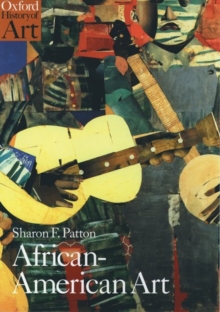African-American art has made an increasingly vital contribution to the art of the United States from the time of its origins in early-eighteenth-century slave communities.
Folk and decorative arts such as ceramics, furniture, and quilts are discussed alongside fine art - sculpture, painting, and photography - produced by African Americans, both enslaved and free, throughout the nineteenth century.
Twentieth-century developments are given full coverage, particularly the New Negro Movement of the 1920s, the Era of Civil Rights and Black Nationalism through the 1960s and 1970s, and the emergence of new black artists and theorists in the 1980s and 1990s.
New evidence has provided an exciting myriad of perspectives about African-American art, confirming that it represents the culture and society from which it emerges.
Professor Patton explores significant issues such as the relationship of art and politics, the influence of galleries and museums, the growth of black universities, critical theory, the impact of artists' collectives, and the assortment of art practices since the 1960s. African-American Art shows that in its cultural diversity and synthesis of cultures it mirrors those in American society as a whole. 'African-American Art should be read by teachers, students, and writers, and on the shelves of every library.
Professor Patton begins this impressive book with the slave ships that brought Africans to this country and gives evidence of the fine metalworking, carving, carpentry, basketry, weaving, and clay building skills passed from Africa through the works of valued but nameless slave-artisans.
She tells how we learned accidentally about a few named artists like the slave, Scipio Moorhead, who in 1773 engraved the only surviving image of poet, Phyllis Wheatley.
She describes the portraitists, furniture makers and highly skilled artisans.
Sharon Patton follows a path leading from great African formal styles, which, mixed with the powerful expressive force of struggle and opposition, led to distinctive new ideasfrom the quilts of Harriet Powers in the late 1800s to the paintings of Jean Michel Basquiat in the 1980s. She helps the reader to think and search for the evidence of the art-making skills that not only survived the Middle Passage, but the many erasings of the auction block and racism's lack, little and denial.
In a fine survey of contemporary African-American art and ideascomplete with words from the artists themselvesPatton takes us first through its foundations and the through the movements, people and ideas that surrounded and generated this art.
An art historian, curator, and scholar, Patton has produced a volume which, like no other, can be used both as an unusual reference book and a good read on an important part of American art.
The illustrations are a special treat.' Emma Amos, Artist Professor of Art, Rutgers University 'For a long period of time there has been an acknowledged need for a comprehensive text that integrates the full range of African American artistry, the building crafts, slave craftsmanship, the decorative and the fine arts tradition into one scholarly document. Professor Patton has brought those elements of history into her text that are often omitted in the available texts on the subject of African-American art and much of what she has written is primary information not previously recorded outside the context of social history.
The cultural context in which Professor Patton has written accounts of the artistry of African-American artists and craftsmen from the period of American slavery to the present is illuminating, analytically sound, and well documented.
She has brought to the attention of the reader a number of topics such as 'Art Institutions and the Artist's Groups' that have not been thoroughly discussed in previous texts on the subject.
A subject such as 'The Plantation House', the place where many decorative arts originated in the slave society is a welcomed addition to Professor Patton's historical overview.' David Driskell, Artist Distinguished University Professor of Art, University of Maryland 'Sharon Patton has written a much needed text which surveys the broad scope of the history of African-American art from slavery to the present. She has followed a different tack, tracing art themes and their development throughout the history, rather than the influences of specific artists or periods.
Thus, she shows how ideas such as crafts, formal painting and sculpture, or architecture, co-existed with equal importance to the culture from the times of the Colonies.
In so doing, she breaks down the barrier between folk and formal art, and articulates an interrelationship of both concepts to African-American people and their culture.
Her book expands the framework for the visual arts in the United States in the last two centuries.' Professor Keith Morrison, Dean, College of Creative Arts, San Francisco State University

